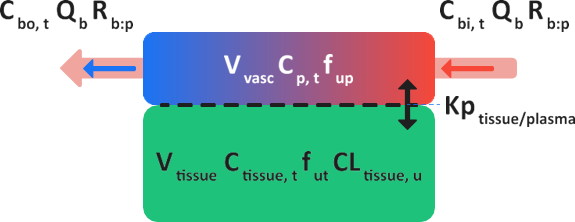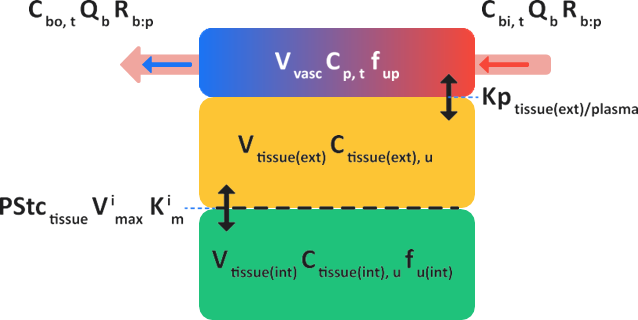Tissue Models for PBPK
In GastroPlus®, you can independently define each tissue as either perfusion-limited or permeability-limited. See:
Permeability limited tissue model (no lysosomal compartment)
Permeability limited tissue model (with lysosomal compartment)
Perfusion-limited tissue model
If tissue permeability is high, then the blood flow rate (perfusion rate) through the tissue limits the amount of drug that partitions into the tissue. A partition coefficient, Kp, is used to calculate the amount of drug that is in the tissue at each time step. Partitioning is assumed to be instantaneous between blood and tissue. The partition coefficient is be estimated from physicochemical properties (logP, pKa(s)), the blood/plasma concentration ratio, fup, and fut. Figure 2-1 is a schematic of a perfusion-limited tissue model in GastroPlus®.
Figure 2-1: Schematic of a perfusion-limited tissue model in GastroPlus®

where:
Variable | Definition |
The local tissue blood flow rate. | |
The total concentration of drug in arterial (in) blood and venous (out) blood in tissue. | |
The blood/plasma drug concentration ratio. | |
The tissue/plasma partition coefficient. | |
The volume of the plasma compartment in the tissue and the total concentration of the drug in the plasma compartment in the tissue. | |
The volume of the tissue compartment and the total concentration of the drug in the tissue compartment. | |
The fraction of drug unbound in the plasma and in the tissue compartment, respectively. | |
The unbound intrinsic clearance rate for the current tissue. |
A perfusion-limited tissue can be non-eliminating or eliminating with intrinsic clearance. In a non-eliminating perfusion-limited tissue, Equation 2-1 shows that the change in mass within the tissue is equal to the product of tissue blood flow and the difference between the blood concentrations in the arterial and venous compartments, where the venous blood concentration is represented as the drug concentration in tissue corrected for red blood cell binding divided by the tissue:plasma partition coefficient, or Kptissue/plasma.
Inspection of this equation shows that as Kptissue/plasma increases, the blood concentration of drug that leaves the tissue (Cbo) decreases, which results in more drug being accumulated in the tissue.
Equation 2-1: Perfusion-limited tissue model, non-eliminating tissue
For eliminating tissues with intrinsic clearance Equation 2-1 must be modified to include the clearance term as shown in Equation 2-2. The product of clearance multiplied by the unbound tissue concentration is divided by the tissue:plasma partition coefficient, Kptissue/plasma, to form the clearance term.
Equation 2-2: Perfusion-limited tissue model, eliminating tissue with intrinsic clearance
In GastroPlus®, the clearance term (CL) that is used in Equation 2-2 is the unbound intrinsic clearance rate for the current tissue, which is represented as CLtissue,u.
The unbound intrinsic clearance rate for the current tissue can also be calculated from the sum of all the enzymes entered for the tissue with their respective enzyme kinetic Vmax and Km values as shown in Equation 2-3.
Equation 2-3: Unbound intrinsic clearance rate calculated from the sum of all tissue enzyme kinetics
where is Ctissue,u is the concentration of unbound drug in the current tissue.
For a simulation, you can enter the value for the unbound intrinsic clearance rate, or you can enter the value for the systemic (plasma) clearance rate. GastroPlus® then calculates the value for the unbound intrinsic clearance rate from the systemic clearance rate. Equation 2-4 shows the equation for this calculation.
Equation 2-4: Unbound intrinsic clearance converted to systemic clearance
where:
Variable | Definition |
The plasma and blood clearance rates, respectively. | |
The blood/plasma drug concentration ratio. | |
The unbound intrinsic clearance rate for the current tissue. | |
The local tissue blood flow rate. | |
The fraction of drug unbound in the plasma. |
Permeability-limited tissue model (no lysomal compartment)
If tissue permeability of the drug is low, then the permeability and the surface area that is available for permeation limit the amount of drug that partitions into the tissue. A (permeability*surface area) product, PStc, is used to calculate the rate of drug transfer into or out of the tissue. Initially, drug concentration in the tissue is less than the concentration of unbound drug in the blood, while later, it is more. The partition coefficient, Kpext/plasma, serves to determine the concentration of the drug that is in the extracellular space in the tissue compartment, while PStc limits the drug entry into and exit from the intracellular space in the tissue compartment. In addition to the passive permeability, saturable transport mechanisms for both influx and efflux can govern drug entry into and exit from the intracellular space in the tissue compartment. Figure 2-2 is a schematic of a permeability-limited tissue model in GastroPlus®.
Figure 2-2: Schematic of a permeability-limited tissue model in GastroPlus®

where:
Variable | Definition |
The local tissue blood flow rate. | |
The total concentration of drug in arterial (in) blood and venous (out) blood in tissue. | |
The blood/plasma drug concentration ratio. | |
| The volume of the plasma compartment in the tissue and the total concentration of drug in the plasma compartment in the tissue. |
The fraction of drug unbound in the plasma. | |
The volume of the extracellular space in the tissue compartment and the concentration of unbound drug in the extracellular space in the tissue compartment. | |
| The extracellular fluid to plasma partition coefficient. |
| The volume of the intracellular space in the tissue compartment and the concentration of unbound drug in the intracellular space in the tissue compartment. |
The fraction of drug unbound in the intracellular space in the tissue compartment. | |
The (permeability*surface area) product for the tissue. | |
The maximum velocity of the ith transporter. | |
The Michaelis-Menten constant of the ith transporter. |
Similar to the perfusion-limited tissue model, blood in the permeability-limited tissue model flows with a user-specified blood-to-plasma ratio, Rb:p, and a user-specified fraction of drug unbound in plasma, fup. The unbound fraction in the plasma is in equilibrium with the unbound fraction in the extracellular space in the tissue compartment, fu(ext). Equation 2-5 (an equation set) and Equation 2-6 (an equation set) define the rate and partitioning calculations for the permeability-limited tissue model, respectively.
Equation 2-5: Permeability-limited tissue model, rate calculations
Equation 2-6: Permeability-limited tissue model (no lysosomes), partitioning calculations
where:
Variable | Definition |
The saturable clearance rate of drug calculated using Michaelis-Menten kinetic. | |
The saturable, carrier-mediated transport rate of drug into the tissue using Michaelis-Menten kinetics. | |
| The saturable, carrier-mediated transport rate of drug out of the tissue using Michaelis-Menten kinetics. |
| The number of enzymes specified for the tissue of interest. |
The number of influx transporters between the extracellular space and the intracellular space in the tissue compartment. | |
| The number of efflux transporters between the extracellular space and the intracellular space in the tissue compartment. |
The maximum velocity of the ith transporter/enzyme. | |
The Michaelis-Menten constant of the ith transporter/ enzyme. | |
| The total concentration of drug in the extracellular space in the tissue compartment and the concentration of unbound drug in the extracellular space in the tissue compartment, respectively. |
The exchange of drug between the extracellular space and the intracellular space via a combination of passive processes and transporter-mediated processes. | |
The (permeability*surface area) product for the tissue. | |
| The total concentration of drug in the intracellular space in the tissue compartment and the concentration of unbound drug in the intracellular space in the tissue compartment, respectively. |
| The rate of clearance of the unbound drug in the intracellular space in the tissue compartment. |
Note: All other variables have been defined previously for Figure 2-2. | |
As shown in the equation sets Equation 2-5 and Equation 2-6, the access of the drug to the extracellular space in the permeability-limited model is controlled exactly like the perfusion-limited model (see Perfusion limited tissue model), with the addition of a tissue permeability term (Ptissue) that governs not only passive entry and exit but also the active influx and efflux to and from the intracellular space in the tissue compartment. The overall change in intracellular concentration with respect to time is a combination of the passive and carrier-mediated permeability, saturable metabolism, and intrinsic clearance.

As Equation 2-6 shows, the selected fut method determines passive diffusion. Passive diffusion can be driven by the difference between the total, unbound drug concentrations in the extracellular and intracellular spaces (see Lukacova calculation method) or by the difference between the neutral, unbound concentrations in the extracellular and intracellular spaces (See Kp based tissue calculations (Default method)).
Permeability-limited tissue model (with lysosomal compartment)
The PBPK model in GastroPlus® also accounts for partitioning into lysosomal compartments. All equations in Equation 2-6 (an equation set) were extended to account for drug exchange between the intracellular space and lysosomal compartments with permeability-limited tissues. The model assumes that the drug exchange between the intracellular space and lysosomal compartments is via passive diffusion only (no transporter effects) and that the passive permeability is the same as for the cellular membrane. As a result, the rate constant for this process is estimated by scaling the respective permeability-surface area product for the tissue, PStctissue, by the lysosomal volume fraction. Equation 2-7 (an equation set) describes this method of drug exchange.
Equation 2-7: Permeability-limited tissue model (w/ lysosomes) partitioning calculations
where:
Variable | Definition |
The concentration of neutral, unbound drug in the intracellular space in the tissue compartment. | |
| The concentration of neutral, unbound drug in the extracellular space in the tissue compartment. |
The concentration of neutral, unbound drug in the lysosomal compartment. | |
The total volume of the lysosomal compartment. | |
The volume fraction of lysosomes in tissue. | |
The total concentration of drug in the lysosomal compartments. | |
Note: All other variables have been defined previously for Figure 2-2. and Equation 2-6. | |
